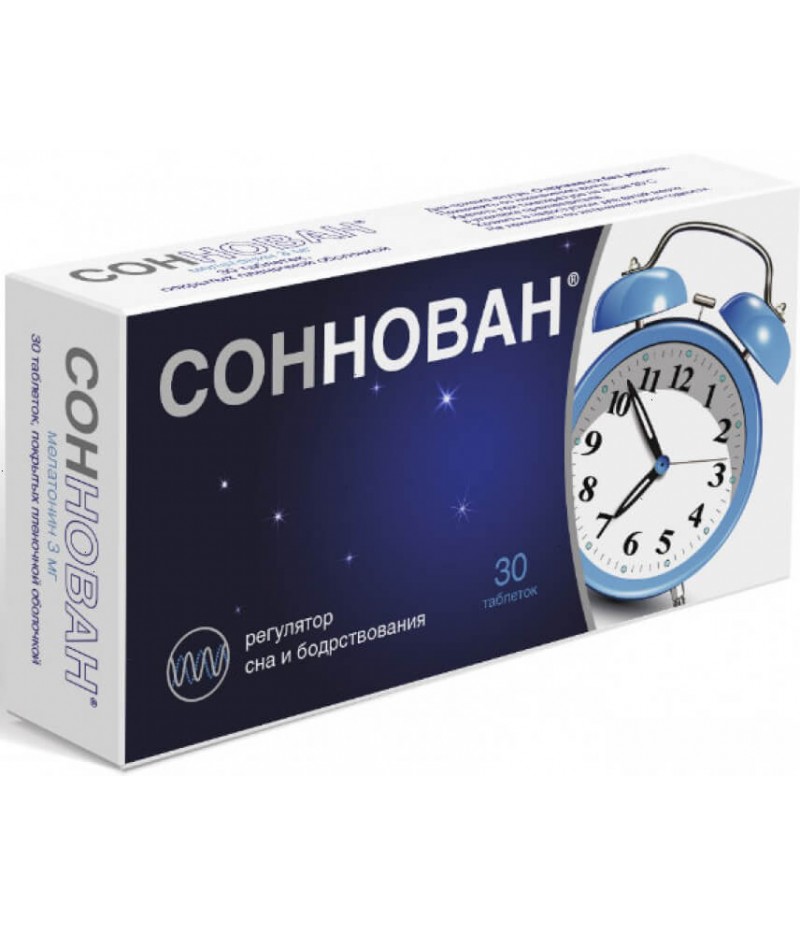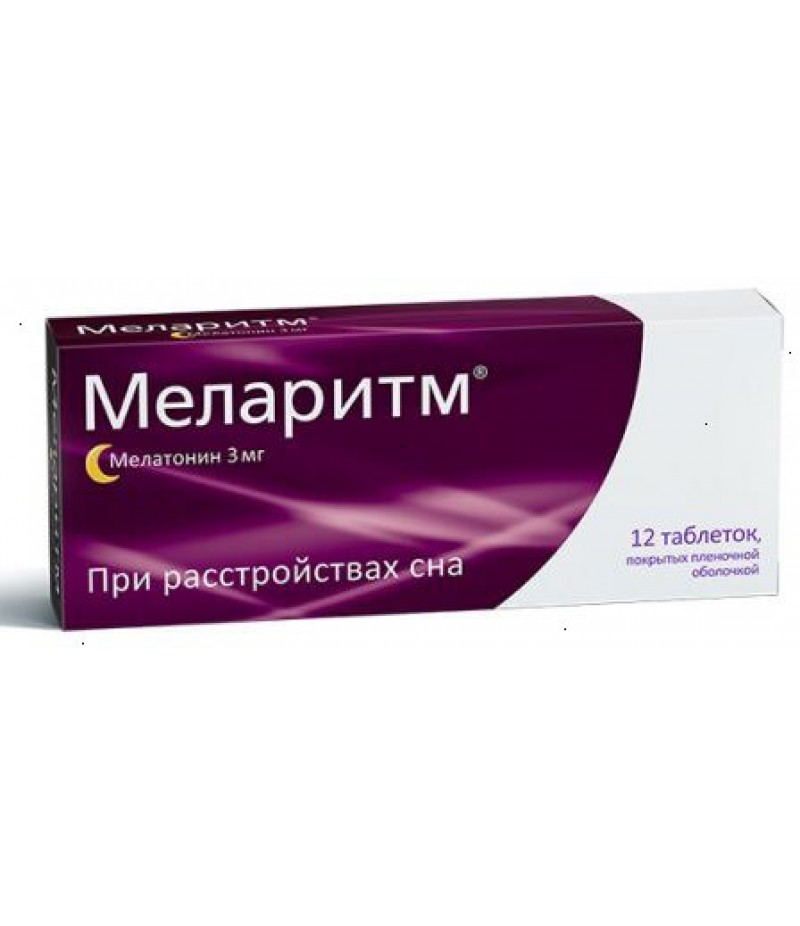Sonnovan tabs 3mg #30
- $28.79
- 3 or more $28.50
- Availability:In Stock
Sonnovan instruction for useReed more and buy Sonnovan on this pageRelease formRound, biconvex tablets with risky, film-coated white color. In cross section, almost white.Composition1 tablet, film coated, contains:active ingredien..
Tags: tabs
Sonnovan instruction for use
Reed more and buy Sonnovan on this page
Release form
Round, biconvex tablets with risky, film-coated white color. In cross section, almost white.
Composition
1 tablet, film coated, contains:
active ingredient: melatonin 3 mg;
excipients: calcium hydrophosphate 112 mg, pregelatinized corn starch 3.5 mg, magnesium stearate 1.5 mg, microcrystalline cellulose 40 mg;
film coating composition: opadry 85F48105 II white 5 mg, including: polyvinyl alcohol 2.345 mg, macrogol (polyethylene glycol 4000) 1.18 mg, talc 0.87 mg, titanium dioxide 0.605 mg.
pharmachologic effect:
adaptogenic agent.
Sonnovan, indications for use
For sleep disorders, incl. caused by the disturbance of the rhythm “sleep-wake”, such as desynchronosis (abrupt change of time zones).
Contraindications
Hypersensitivity to the components of Sonnovan, autoimmune diseases, liver failure, severe renal failure, children under 18 years of age.
Dosage and administration
Inside When sleep disorders, desynchronosis - 1 tablet once a day for 30-40 minutes before bedtime.
When used as an adaptogen when changing time zones, 1 day before the flight and for the next 2-5 days, 1 tablet 30-40 minutes before sleep.
The maximum daily dose is 6 mg.
Elderly patients
With age, there is a decrease in melatonin metabolism, which must be considered when choosing a dosing regimen for elderly patients. Taking this into account in elderly patients, it is possible to take Sonnovan 60-90 minutes before sleep.
Renal failure
The effect of varying degrees of renal failure on melatonin pharmacokinetics has not been studied, so melatonin should be used with caution in such patients. In patients with severe renal insufficiency, the use of Sonnovan is not recommended.
Use during pregnancy and lactation
Sonnovan is contraindicated for use during pregnancy and during breastfeeding.
Side effects
Classification of the incidence of side effects according to the recommendations of the World Health Organization:
very often (≥1 / 10), often (from ≥1 / 100 to
Infectious and parasitic diseases:
rarely: herpes zoster.
Disorders of the blood and lymphatic system:
rarely: leukopenia, thrombocytopenia.
Immune system disorders:
frequency unknown: hypersensitivity reactions.
Metabolic and nutritional disorders:
seldom: hypertriglyceridemia, hypokalemia, hyponatremia.
Mental Disorders:
infrequently: irritability, nervousness, anxiety, insomnia, unusual dreams, nightmares, anxiety;
rarely: mood swings, aggression, agitation, tearfulness, symptoms of stress, disorientation, early morning awakening, increased libido, low mood, depression.
Nervous system disorders:
infrequently: migraine, headache, lethargy, psychomotor hyperactivity, dizziness, drowsiness;
rarely: fainting, impaired memory, impaired concentration, delirium, restless legs syndrome, poor sleep quality, paresthesia.
Violations by the organ of vision:
rarely: decreased visual acuity, blurred vision, increased tearing.
Disturbances from an organ of hearing and labyrinth disturbances:
rarely: vertigo, positional vertigo.
Violations of the cardiovascular system:
infrequently: arterial hypertension;
rarely: exertional angina, palpitations, flushing.
Violations of the gastrointestinal tract:
infrequently: abdominal pain, abdominal pain in the upper abdomen, dyspepsia, ulcerative stomatitis, dry mouth, nausea;
rarely: gastroesophageal disease, gastrointestinal disturbance or disorder, bullous stomatitis, ulcerative glossitis, vomiting, increased peristalsis, abdominal distension, salivary hypersecretion, bad breath, abdominal discomfort, stomach dyskinesia, gastritis.
Disorders of the liver and biliary tract:
infrequently: hyperbilirubinemia.
Violations of the skin and subcutaneous tissues:
infrequently: dermatitis, night sweats, itching and generalized itching, rash, dry skin;
rarely: eczema, erythema, dermatitis of the hands, psoriasis, generalized rash, itchy rash, nail damage;
frequency is unknown: angioedema, edema of the oral mucosa, tongue edema.
Disorders of the musculoskeletal and connective tissues:
infrequently: pain in the limbs;
seldom: arthritis, muscle spasm, neck pain, night cramps.
Kidney and urinary tract disorders:
infrequently: glycosuria, proteinuria;
rarely: polyuria, hematuria, nocturia.
Disorders of the genitals and the breast:
infrequently: menopausal symptoms;
seldom: priapism, prostatitis;
frequency unknown: galactorrhea.
General disorders and disorders at the site of administration:
infrequently: asthenia, chest pain;
rarely: fatigue, pain, thirst.
Laboratory and instrumental data:
infrequently: abnormal laboratory parameters of liver function, weight gain;
rarely: increased activity of liver transaminases, abnormal electrolyte levels in the blood, abnormal laboratory test results.
special instructions
During the period of use of the drug Sonnovan, it is recommended to avoid exposure to bright light.
It is necessary to inform women who want to become pregnant about the presence of a weak contraceptive effect.
There are no clinical data on the use of melatonin in patients with autoimmune diseases, and therefore, the use of this category of patients is not recommended.
Impact on the ability to drive vehicles and mechanisms
The drug Sonnovan causes drowsiness; therefore, during the period of treatment, it is necessary to refrain from driving vehicles and practicing potentially hazardous activities that require an increased concentration of attention and quickness of psychomotor reactions.
Interaction
Pharmacokinetic interaction
It is known that at concentrations significantly higher than therapeutic, melatonin induces the CYP3A isoenzyme in vitro. The clinical significance of this phenomenon is not fully understood. In the case of signs of induction, consideration should be given to reducing the dose of simultaneously used drugs.
At concentrations significantly higher than therapeutic, melatonin does not induce isoenzymes of the CYP1A group in vitro. Consequently, the interaction of melatonin with other drugs due to the effect of melatonin on the isoenzymes of the CYP1A group is apparently insignificant.
Melatonin metabolism is mainly mediated by CYP1A isoenzymes. Therefore, melatonin may interact with other drugs due to the effect of melatonin on the isoenzymes of the CYP1A group.
Care should be taken with patients taking fluvoxamine, which increases the concentration of melatonin (an increase in AUC by 17 times and Cmax by 12 times) due to inhibition of its metabolism by cytochrome P450 isoenzymes: CYP1A2 and CYP2C19. This combination should be avoided.
Caution should be exercised in patients taking 5- and 8-methoxypsoralen, which increases the concentration of melatonin due to inhibition of its metabolism.
Caution should be exercised in patients taking cimetidine (an inhibitor of CYP2D isoenzymes), since it increases the plasma melatonin content by inhibiting the latter.
Smoking can reduce melatonin concentration by inducing CYP1A2 isoenzyme.
Caution should be exercised with patients taking estrogens (for example, contraceptives or hormone replacement therapy), which increase the concentration of melatonin by inhibiting their metabolism with CYP1A1 and CYP1A2 isoenzymes.
Inhibitors of CYPA2 isoenzymes, for example, quinolones, can increase the melatonin exposure.
CYP1A2 isoenzyme inducers, such as carbamazepine and rifampicin, can decrease the plasma concentration of melatonin.
In modern literature there is a wealth of data concerning the effects of adrenergic and opioid receptor agonists / antagonists, antidepressants, prostaglandin inhibitors, benzodiazepines, tryptophan and alcohol on the secretion of endogenous melatonin. Studies of the mutual influence of these drugs on the dynamics or kinetics of melatonin was not conducted.
Pharmacodynamic interaction
While taking melatonin should not drink alcohol, as it reduces the effectiveness of Sonnovan.
Melatonin potentiates the sedative effect of benzodiazepine and non-benzodiazepine hypnotics, such as zaleplon, zolidem, and zopiclone. During the clinical study, there were clear signs of a transient pharmacodynamic interaction between melatonin and zolpidem an hour after their intake. Combined use may lead to progressive disorder of attention, memory and coordination in comparison with zolpidem monotherapy.
In the course of the research, melatonin was administered together with thioridazine and imipramine, drugs that affect the central nervous system. No clinically significant pharmacokinetic interaction was found in any of the cases. However, simultaneous use with melatonin led to an increased sense of calm and difficulty in performing certain tasks in comparison with imipramine monotherapy, as well as to an increased feeling of "clouding in the head" compared to thioridazine monotherapy.
Overdose
According to available literature data, the use of melatonin in a daily dose of up to 300 mg did not cause clinically significant adverse reactions. Hyperemia, abdominal cramps, diarrhea, headache and scotoma were observed with the use of melatonin in doses of 3,000 - 6,600 mg over several weeks. With the use of very high doses of melatonin (up to 1 g), involuntary loss of consciousness was observed. Overdose may cause drowsiness. Treatment - gastric lavage and the use of activated carbon, symptomatic therapy. Clearance of the active substance is assumed within 12 hours after ingestion.
Storage conditions
Shelf life - 2 years. Do not use after the expiration date.
At a temperature not higher than 25 ºС in the manufacturer's packaging. Keep out of the reach of children.
Terms of sell
To buy Sonnovan the prescription is not required.


